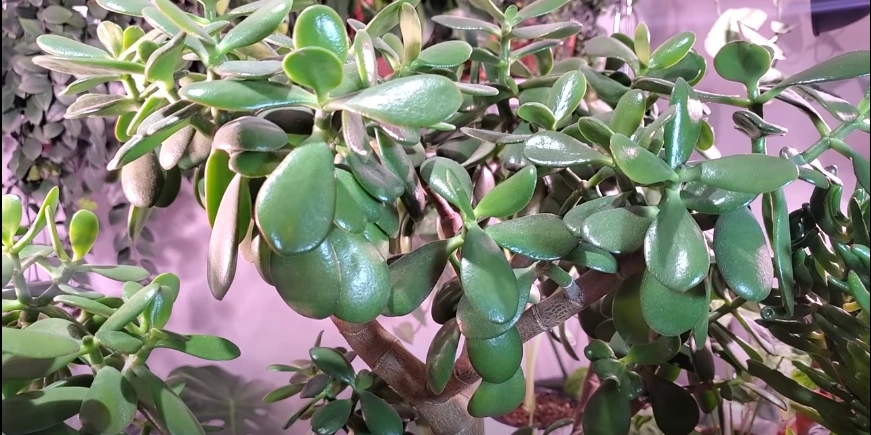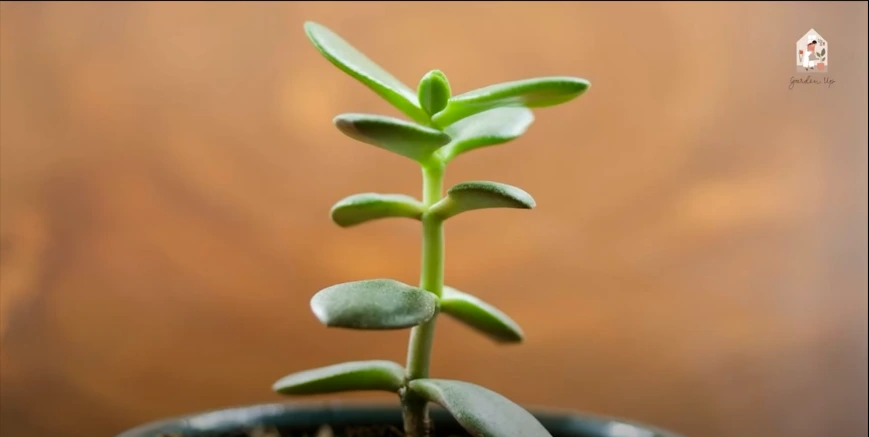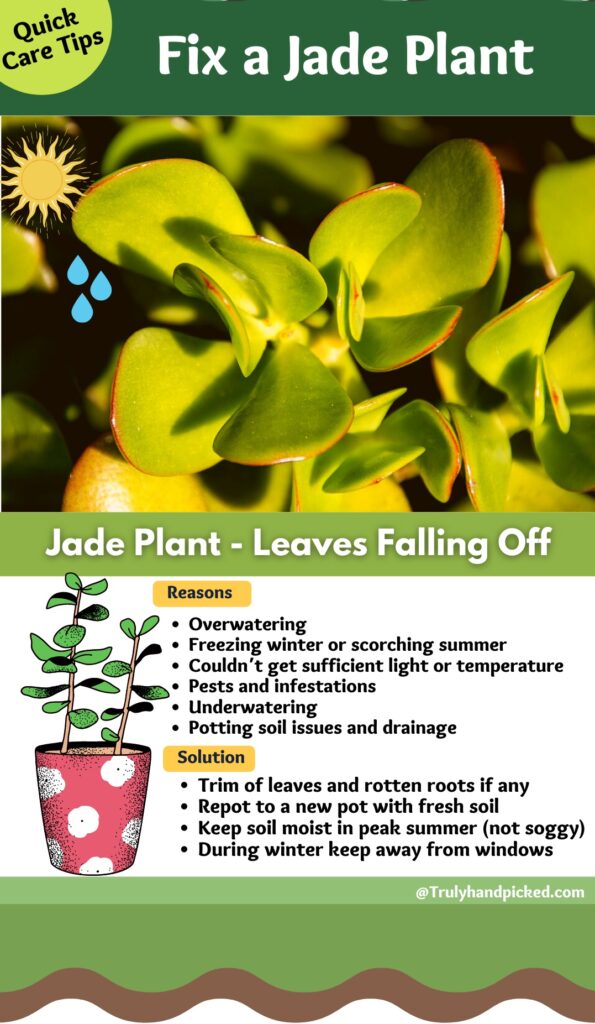Jade plants are sun-loving succulents and prefer well-draining loamy acidic soil. Cactus potting mix and occasional watering and addressing bugs and mites with rubbing alcohol and neem oil will keep your jade plants healthy. Avoid overwatering and scorching sunlight that may burn leaves.
Jade Plant Leaves Complete Care – Issues & Fix
Jade Plant Leaves Turn Yellow
Reasons for Jade Plant Leaves Turning Yellow:
- Overwatering: Soil remains consistently damp, leading to waterlogged roots.
- Inadequate drainage: Pot lacks drainage holes or the soil doesn’t drain well, causing moisture buildup.
- Underwatering: Prolonged dryness and dehydration stress the plant.
- Insufficient light: Lack of bright, indirect light affects leaf health.
- Temperature and humidity: Extreme temperatures or high humidity levels can cause yellowing.
How to Fix:
- Adjust watering routine: Allow soil to dry out between waterings, ensuring thorough watering and drainage.
- Improve drainage: Use well-draining soil and pots with drainage holes, consider adding gravel or perlite.
- Establish a watering schedule: Keep soil moderately moist, avoiding both overwatering and underwatering.
- Provide adequate light: Place near a sunny window or use grow lights, avoiding direct, intense sunlight.
- Maintain optimal temperature and humidity: Keep the plant in a temperature range of 65-75°F (18-24°C) and moderate humidity levels.
Video on Jade Plant Leaf Care
Jade Plant Leaves Wrinkled:
- Underwatering or inconsistent watering.
- Low humidity levels.
How to Fix:
- Adjust the watering schedule to ensure the soil is moderately moist.
- Increase humidity around the plant by misting the leaves or placing a tray of water nearby.
Jade Plant Leaves Falling Off:
- Overwatering or waterlogged roots.
- Sudden changes in environmental conditions or temperature.
- A pest infestation, such as mealybugs or spider mites.
Solution:
- Improve drainage by using well-draining soil and pots with drainage holes.
- Avoid drastic temperature changes and provide a stable environment.
- Inspect the plant for pests and treat accordingly using appropriate methods or insecticidal soap.
Jade Plant Leaves Drooping:
- Underwatering or inconsistent watering.
- Excessive heat or direct sunlight.
Fix:
- Water the plant thoroughly when the top inch of soil feels dry.
- Ensure the plant is placed in a location with bright, indirect light rather than intense direct sunlight.
Jade Plant Leaves Curling:
- Inadequate watering, either underwatering or overwatering.
- Extreme temperature changes or drafts.
How To:
- Adjust the watering routine to maintain moderate soil moisture.
- Protect the plant from sudden temperature changes and avoid placing it near drafts.
Jade Plant Leaves Turning Brown:
- Overwatering or waterlogged roots.
- Underwatering or prolonged dryness.
- Exposure to cold drafts or temperature extremes.
Fixes:
- Improve drainage to prevent waterlogging.
- Adjust watering to keep the soil moderately moist.
- Protect the plant from cold drafts and provide stable temperatures.
Jade Plant Leaves Drying Out:
- Underwatering or insufficient humidity.
- Exposure to excessive heat or direct sunlight.
Fixes:
- Ensure adequate watering to maintain moderate soil moisture.
- Increase humidity levels around the plant through misting or using a humidifier.
- Move the plant to a location with bright, indirect light rather than intense sunlight.
Jade Plant Leaves with Black Spots:
- Fungal or bacterial infections.
- Overwatering or prolonged moisture on the leaves.
Solution:
- Remove affected leaves to prevent the spread of infection.
- Adjust watering to prevent excess moisture on the leaves.
- Treat with appropriate fungicides or bactericides if necessary.
Jade Plant Leaves Turning Red:
- Exposure to direct sunlight or high light levels.
- Environmental stress, such as extreme temperatures or drafts.
Fixes:
- Move the plant to a location with bright, indirect light rather than direct sunlight.
- Protect the plant from extreme temperature fluctuations and drafts.
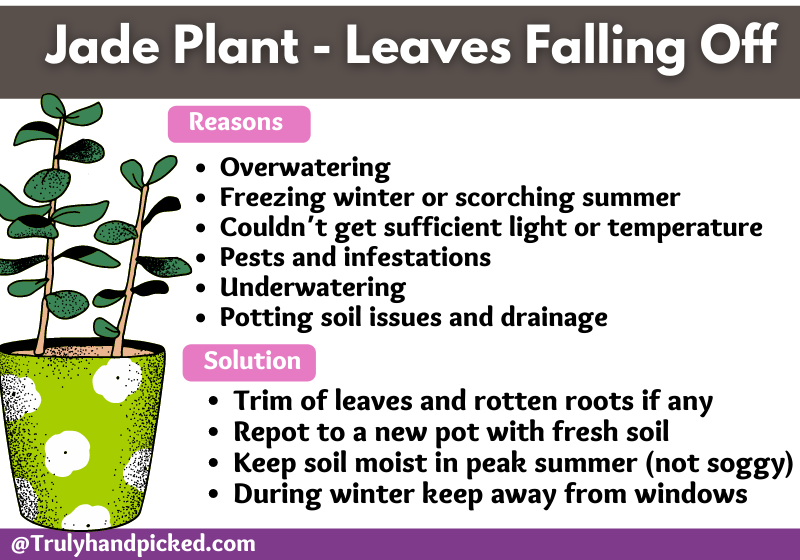
Jade Plant Leaves Falling Off:
Falling leaves are a very common problem a growing jade plant could have. It could appear for several reasons. A jade plant usually gives signs of its improper handling method through this falling leaves issue.
You need to pay attention and find out the real cause behind it, to cure the problem deeply of its root. Some of the typical causes of failing off are-
Reasons
- You are overwatering your jade plant
- When you keep your growing plant underwatering for more than 3 weeks
- Freezing winter and scorching summer
- If your plant couldn’t get sufficient light or temperature
- When you stay inattentive for long and let the pests or bugs infest
- If you sow the plant in an infected wrong potting soil
- When you pick an unsuitable type of soil to plant a jade plant
- If you overfertilize your plant with low-nitrogen plant food
- And when you have root rot from water for soil issues
In each case, you have to treat the problem from its source to get rid of it performantly. Repotting to a new pot with fresh potting soil after trimming off the unwanted roots and leaves will revive the plant.
For indoor plant beginners, you can also check for quick-fix ideas on reviving overwatered peace lily plants and saving an overwatered succulent.
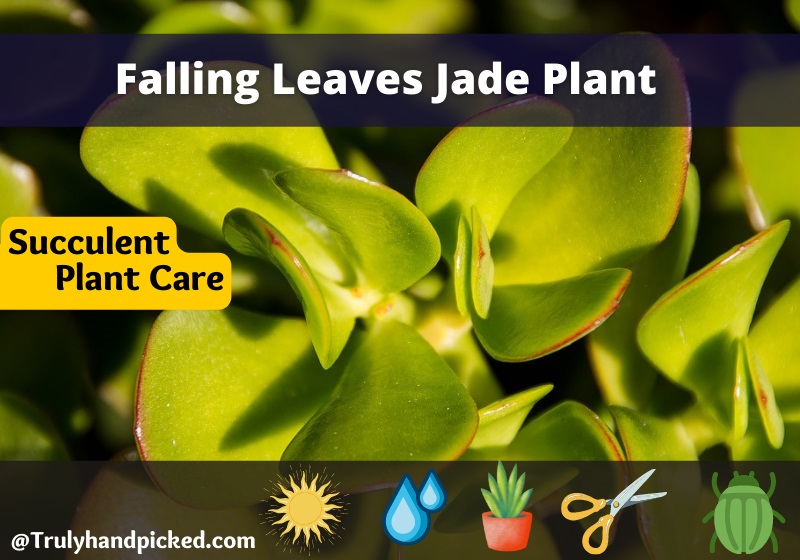
Video on Jade Plant Complete Care – Garden Up
About Jade Plants
Jade plants are slow, but easy-to-grow houseplants from the succulent family. This is Crassula oavata commonly known as the lucky plant or money plant.
Jade plants always grow in a beautiful narrow-to-wide shape starting from the small tree-like log to the top. This pattern provides it with an organized form, despite its bushy texture.
Sometimes it cultivates pink or white flowers with proper care and attention. Here are some must-know facts about this beautiful succulent houseplant, you should know before picking one for your indoor garden-
Related: Save an overwatered rubber plant
Jade Plant Complete Care: Quick Precap
Soil: Loamy well-drained soil with slightly acidic quality
Water: Few and infrequent watering around once every 2-3 weeks. Overwatering will result in drooping leaves or leaves starting to fall off.
Fertilizer: Any high-nitrogen all-purpose fertilizer
Sun Exposer: Bright light near the southeast window(growing indoors) is the best place to give enough sun exposure for indoor jade plants. Avoid too shady spots, bathrooms, and bedrooms as succulents are sun lovers.
Hardiness Zones: 10 to 11
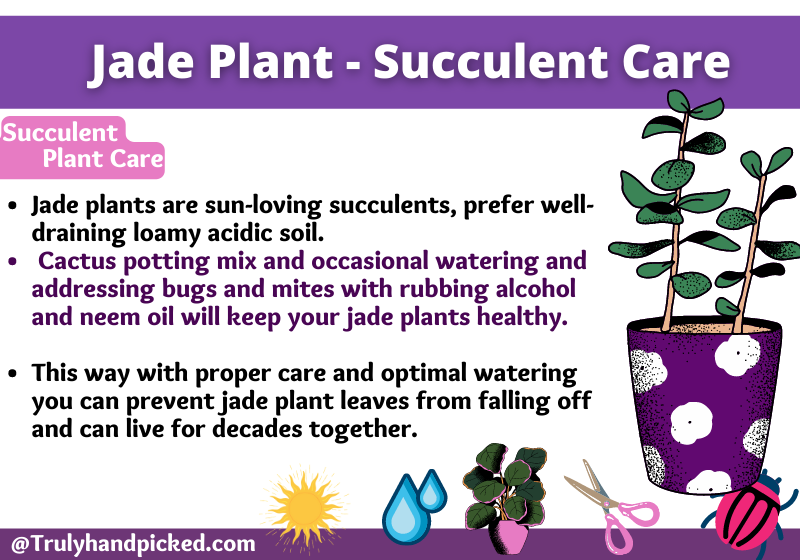
How to Care of Jade Plant
Now, take a look at the caring details in these points below-
Soil and Potting Mix:
Use normal cactus potting soil mixed with sand and peat moss. Keep quality slightly acidic and maintain the pH within 6.0 to 6.5 for the best result. Make sure the soil drains well and never make the soil soggy for a healthier root system.
Related: Reasons and fix for poinsettia dropping leaves
When and How to Water:
Don’t water your indoor jade plant often as it belongs to the succulent family and thus, doesn’t need much mist to thrive. Let the top surface of the soil completely dry around 1-2 inch depth from one water session to another. Water your plant once every two weeks (depends upon climate too). Also avoid watering them in winter, as they mostly go in a dormant state during the entire season.
Fertilizer Needs:
A growing jade plant craves nitrogen-soluble fertilizer. You can pick any commercial plant food or homemade fertilizer, but be sure it is high in nitrogen content. Apply it with a 10-20-10 NPK ratio. Use fish emulsion to fertilize your plant to feed it organically.
Sunlight Needs and Temperature:
Place your plant in a warm spot where it can get 6-7 hours of indirect sunlight every day. You should remember that it is a hardy plant and thus compatible with normal room temperature. Keep the temperature between 65-75 degrees F with moderate humidity around 30-50% throughout the entire growing session.
How to Prune
Keep your plant neat and clear from nasty or untidiness. Pruning is an essential part of this process. Keep discolored, curvy or any disputed leaves trimmed away from your plant. Cut off the bacterial or fungal-infested parts as well along with disputed leaves during this pruning session. This way you can keep your plant in shape and clean all the time.
Repotting
Though being a bushy succulent, you can replant or repot a growing jade plant when it has outgrown the pot. It encourages growth more optimally. Try to replant your jade plant after every 2-3 years to keep its growth level consistent. Use a 2-3 inch bigger pot, every time you replant it from its current planter.
Jade Plant Pests and Remedies:
The jade plant is succulent and thus allures several bugs or mites to its juicy leaves easily. Mealybugs, grasshoppers, spider mites, etc. are some common problems you may face with a healthy jade plant. Try using natural remedies than any chemical-based pesticides. Rubbing alcohol, neem oil, soapy water, etc. are some good options you can use here.
Simple and easy ways to get rid of mealybugs and keep spidermites off your plants.
Benefits of Growing Jade Plant:
If you pick a jade plant to grow as a houseplant, you will have plenty of advantages with it, besides its super-classy glance. Some of the common benefits of a jade plant are-
- Like the utmost houseplants, a jade plant effectively works as a natural air purifier
- It can improve the humidity and maintain a higher humidity, even during the winter season
- A jade plant is an expert in absorbing carbon dioxide and thus increasing the oxygen of the room it places
- High humidity and a good air-purification system help us to deal with several mild issues like dry skin, congested respiratory system, itchy throat, clod & flue, etc. effectively
- This is one of the easy-to-grow succulents you can have indoor
- According to the Feng-Shui, the jade plant is considered a symbol of good luck, wealth, and prosperity
- And its mini-tree-like shape makes it a perfect option for a miniature garden from every aspect
So, if you are planning to grow a jade plant, don’t think twice. It is one of the most hassle-free succulent houseplants you can cultivate indoors.
Can I eat a cactus? List of edible cactus plants and fruits.
How to Propagate Jade Plant:
Propagation of a jade plant is normal like any other houseplant, even easier than some other bushy succulents. Let’s learn how to do it properly-
- First of all, prepare to cut some leaves with a stem out of a fully-grown jade plant
- Don’t forget to disinfect the cutter or any garden tool that you are going to use here
- Now cut off the healthy young stem with its nod and remove 2-3 leaves from the bottom
- Now you can keep the stem inside a watery object or plant it directly in a planter, prepared with potting soil
- Use some pebbles around the base of your planter, every time you replant or grow a jade plant from its cutting
- If you want to grow it from offshoots, simply pick one shot to contain 2-3 leaves and place it in a glass full of water
- Let the bottom steep into the water for 1-2 weeks and once the roots develop, replant them in a planter properly
- Make sure you put the newly planted cutting in a warm location in your house
- Finally, provide it proper growing climate and get a fully thriving jade plant within 1 year.
Related: Reasons why crotons are dropping leaves
Pinterest Image
FAQ
How Often to Water Jade Plant?
Try to water your growing jade plant once every 2-3 weeks or wait till the top surface of the soil turns completely dry with a 1-2 inch depth.
